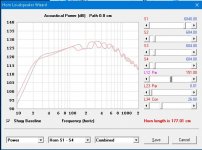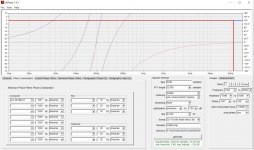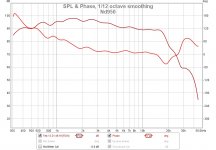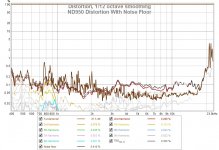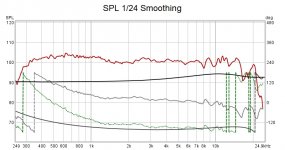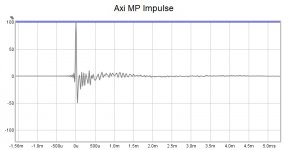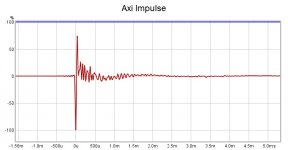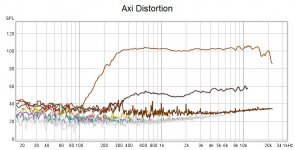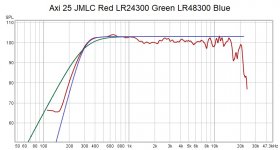OK, I was hoping that you were referring to the last segment. I didn't hear from you since I posted so I just assumed that you found it acceptable but, here's the skinny. The guys on the TL fb group pointed out such, so when I measured, I did so in a straight line, through the bottom section, since that is what it will more so function like, as they suggested, and you are complimenting that, as well. So, I am really ~16" over on length. Playing with HornResp, this 10;1 recipe is really forgiving, as long as startings vs terminus, 10:1 ratio is kept you can play with length and CSA in between start and finish and get all sorts of acceptable frequency responses. I'm going to do another sim with 4 segments so I can mimic the skinny pinch that separates the two segments, leaving out the inadequate steps, but I'm expecting to see a response about identical to what I've tried to sim already to figure how my box sounds, shown in the pink line.
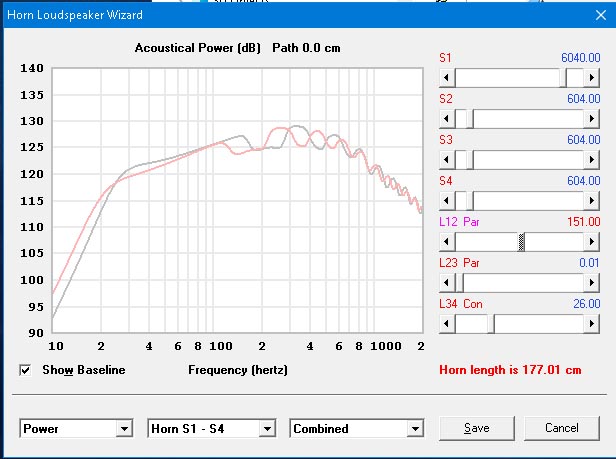
Yes I know in this sim I have the 604 for 10inches, vs how mine tapers till the end, but the sims I did to represent that, where about the same I just happened to have this pic already and it shows what type variation we are looking at, as long as I measure length in a logical way..... from the middle of the driver to middle of the downward channel, down to the middle of lower lane and straight out the middle of the exit. Is there a better way to measure or how do you suggest I model it to predict its performance.
I also have another design sitting on the shelf, another iteration that splits csa into 2, then I'd end up with ports on top and bottom. or each side if I turn it over. This might be a better route, folded like some tapped horns, I would have skinny on the beginning CSA to keep the height or width in check....but not by much....let me see what I can do.
Here the wiki I was referring to
Transmission line loudspeaker - Wikipedia
Yes I know in this sim I have the 604 for 10inches, vs how mine tapers till the end, but the sims I did to represent that, where about the same I just happened to have this pic already and it shows what type variation we are looking at, as long as I measure length in a logical way..... from the middle of the driver to middle of the downward channel, down to the middle of lower lane and straight out the middle of the exit. Is there a better way to measure or how do you suggest I model it to predict its performance.
I also have another design sitting on the shelf, another iteration that splits csa into 2, then I'd end up with ports on top and bottom. or each side if I turn it over. This might be a better route, folded like some tapped horns, I would have skinny on the beginning CSA to keep the height or width in check....but not by much....let me see what I can do.
Here the wiki I was referring to
Transmission line loudspeaker - Wikipedia
Attachments
Last edited:
OK then more thoughts for youI just meant you covered many areas. Don't stop lol, its very thought provoking.
Ah, I thought this was for mixing, so I had that wrong. I have an electronic drum kit and have used a computer with VST as playback, the lower the latency the better for that application and sub 10ms is ideal, you can learn to deal with more but you do have to be quite good to do that and it's hard to be completely consistent.Stereo bass just makes sense to me, it also compliments the experience when I play video games. Same thing goes for latency. As a competitive gamer I am familiar with ms as a unit of time......Also, input latency and keyboard drumming has exposed me to latency and its limitations. So I just opened my DAW to test out some latencies . I think I have been over critical in the past....but at the same time maybe not...I stated that 10ms was my tolerance
It doesn't have to be one or the other though, you can switch to linear when using playback only and switch presets to zero delay when you need it. The difference is not night and day in any case but it would give you options to consider. You can also compensate a Linkwitz Riley MP filter with rephase to undo the phase turn and group delay, phase only EQ can usually cope with less taps than needed for changing magnitude. I have attached a rephase screenshot to show that you could go down to 2048 taps and get a pretty close match to the phase characteristic you need which gives a delay of about 23ms.
Have you ever measured off axis to see how far it holds true?Too good to be true because it was perfect tuning to just one mic location.
That's easy to do...too easy really...but it does show the tools we have available today to make precise tuning.
Very trueRelated aside.... whatever you end up building, i would strongly encourage you to envision a prototyping, measuring and altering kinda process.
I've found once sawdust is made, things often turn into 'plans of mice and men'.
This is huge part of speaker tuning / building ime/imo.
Can't really agree with this, that basic idea leads to brute force corrections to make something perfect at one place in space and time. It does not work and sounds wrong. Your head will move and there is nothing you can do about it. This is also part of the reason people have been cautioning you about beaming sources. Off axis and the balance between off and on matters a lot. Double blind testing shows it over and over.The "broader brush" is for some, I think application comes to mind. I'd think that one spot tuning, within that one spot, is going to have better results than if you average several listening spots. Could be wrong.
Look at the impedance plot for where the main resonance is, any speaker will not like to be pushed far below it's resonance and asked to produce any output unless arrayed. Look at harmonic distortion graphs if they are available. When does it start to rise to a point that will become unacceptable? The horn can help with that but it can only go so far. If the driver has a sharp rise at some frequency that trend is likely to be present on other horns too.Its really frustrating that they don't give the xmax-thiele specs for compression drivers and their diaphragms.
This is the Radian that they used to cross at 300hz.... on a 800hz horn....I read that the company worked with Radian to produce this compression driver but thats all I know.
Attachments
.OK then more thoughts for you
...Can't really agree with this, that basic idea leads to brute force corrections to make something perfect at one place in space and time. It does not work and sounds wrong. Your head will move and there is nothing you can do about it. This is also part of the reason people have been cautioning you about beaming sources. Off axis and the balance between off and on matters a lot. Double blind testing shows it over and over....
Are you telling me I can't purposely keep my head still for any significant amount of time lol
Ok but check this out..... Why isn't anyone commenting about how the guys I keep bringing up, crossed over a radian Be at 300hz on a 800hz horn..
So potentially I'll be doing something similar. We have the beaming horn for experiment A, and then I can scale, the horn down to a higher tuning, wider polar, and potentially still be able to crossover the same. But I've made it a point to have 2 horns on each end of the spectrum so I can make that judgement call. I don't believe the high directivity leads to a worse sound, rather, a different sound, so I want to see for myself I guess. Aren't ribbon tweeters pretty beamy too?
Last edited:
Here is a frequency response and noise floor:Chebum, what SPL ? Needs that reference, along with noise floor when levels so low...
Attachments
Can't tell if this is tongue in cheek or not, but no not to the extent necessary for that type of correction to be applicable, from there it is a continuum down as to how spatially specific the correction can be before artifacts intrude, much as mark was saying before about the square waves not looking as good away from that very position, ears and a brain are harder to please than an omni microphone.
Are you telling me I can't purposely keep my head still for any significant amount of time lol
I don't know why, it seems like a bad idea and the company does not seem to offer it for sale any more or any information other than pictures of newer models on their website. That isn't a positive sign for me. The only thing I found said that it had no crossover at all but needed EQ and bi-amplification.Ok but check this out..... Why isn't anyone commenting about how the guys I keep bringing up, crossed over a radian Be at 300hz on a 800hz horn..
So potentially I'll be doing something similar. We have the beaming horn for experiment A, and then I can scale, the horn down to a higher tuning, wider polar, and potentially still be able to crossover the same. But I've made it a point to have 2 horns on each end of the spectrum so I can make that judgement call. I don't believe the high directivity leads to a worse sound, rather, a different sound, so I want to see for myself I guess. Aren't ribbon tweeters pretty beamy too?
Ribbons have high vertical directivity which is useful in some situations and the only downside to it is that it can limit the vertical space over which the sound will be correct, outside that it will sound quite different. This is one aspect of high directivity that can be beneficial because it can limit the floor and ceiling reflections which are more detrimental than horizontal reflections.
It seems to me that you think the sound quality will improve by having a high horizontal directivity speaker, of course you should try it to see for yourself if you think it is worth the effort. I am only trying to point out to you that all of the most reliable double blind testing says that it is not the most preferred sound for most people. If you still want to go down that route then make sure that the change in directivity is as smooth as possible, that seems to be something that could be improved in some of the simulations of horns posted before.
I would not be chasing such a low crossover either, whatever you do choose try to optimize the directivity match between the woofer and horn at the crossover.
Spatial Audio X1 | Audiogon Discussion ForumAs you may know, I had GedLee Abbeys for years. I loved them. There was nothing they didn't do right IMO. After a divorce and loss of listening space and quite frankly really wanting to simplify my stereo and life the thought of the LIO and M3's was refreshing. After having them side by side I decided that I could be happy with this setup for the foreseeable future. What I wasn't expecting was to have an audition of X1's that brought back some listening qualities that I've missed. The shear amount of detail done with such finese of the X1's is simply jaw dropping. I guess the way to put it is that the X1's are the well designed speakers that have that "it" factor while listening
Pretty sure the company went out of business.
"change in directivity is as smooth as possible" - Totally and it is being addressed.
This beaming horn serves a purpose of experimentation. I wanted this system to be so sensitive to level changes, that it was almost exaggerated. In the studio, the opposite of compression is expansion, so, almost expanded, if you will. I'm trying to create a magnifying glass for eqing, the less reflections the better I say.
A low cross over isn't new, and its time proven, it just sounds better, when done right that is, but non the less, my drivers are rated to 300hz I'm not pushing the envelope of the driver...
Last edited:
I can't say I have seen a lot of time proven better sounding systems that cross a horn to a woofer at 300Hz and expect the horn and driver to deliver all the way to the top of the frequency range, maybe I just missed them 
I don't think that you will get what you are looking for in your system from the options you are considering, but, given that you seem set on them, I hope you are satisfied when you get to build them
I don't think that you will get what you are looking for in your system from the options you are considering, but, given that you seem set on them, I hope you are satisfied when you get to build them
+
Not horn systems, because until recently, it wasn't possible, and we aren't even certain if its possible now.
FAST/WAW, I like it, and I want one with a horn.
You do understand that in this thread an Axi user has traded REW measurements from his Axi on a 250hz jmlc? Not exactly flying blind here.... at bare minimum I'll be crossing at 300hz, thats a fact, and yes he likes it to 20khz. It rolls off before 20khz like 19khz. He crossed to a 18" Fane woofer I think. He had a beyma 150h on top before the AXi2050, I'm sure his ear would of been crying if sound quality was lacking due such a wide bandwidth....the problem is noone has an Axi2050 first off....or a radian950BE, so anyone saying what it "can't" do, is just speculating. So I'm kinda planning a pick nick and preparing for rain.
There was another guy who had an Axi and said it crossed fine at 300hz, that it could probably be crossed lower (thanks for not testing bud) and that he like the upper of the 950Be better.....and he also did not test how low he could cross the Radian...I just seen his Radian and horns sold on shark audio so not likely to get him to do it in the future either lol. Which makes me think.....aren't there TAD compression drivers that cross as low as 300hz and cover the rest up top as well?
The last testimony might be mix of two different people...I still haven't grasped this concept Bjorn, is that a name or a french way to address a gentleman?
Keep picking at me though, my words may fight you but my heart loves you lol
Not horn systems, because until recently, it wasn't possible, and we aren't even certain if its possible now.
FAST/WAW, I like it, and I want one with a horn.
You do understand that in this thread an Axi user has traded REW measurements from his Axi on a 250hz jmlc? Not exactly flying blind here.... at bare minimum I'll be crossing at 300hz, thats a fact, and yes he likes it to 20khz. It rolls off before 20khz like 19khz. He crossed to a 18" Fane woofer I think. He had a beyma 150h on top before the AXi2050, I'm sure his ear would of been crying if sound quality was lacking due such a wide bandwidth....the problem is noone has an Axi2050 first off....or a radian950BE, so anyone saying what it "can't" do, is just speculating. So I'm kinda planning a pick nick and preparing for rain.
There was another guy who had an Axi and said it crossed fine at 300hz, that it could probably be crossed lower (thanks for not testing bud) and that he like the upper of the 950Be better.....and he also did not test how low he could cross the Radian...I just seen his Radian and horns sold on shark audio so not likely to get him to do it in the future either lol. Which makes me think.....aren't there TAD compression drivers that cross as low as 300hz and cover the rest up top as well?
The last testimony might be mix of two different people...I still haven't grasped this concept Bjorn, is that a name or a french way to address a gentleman?
Keep picking at me though, my words may fight you but my heart loves you lol
Last edited:
Yes I have read the whole threadYou do understand that in this thread an Axi user has traded REW measurements from his Axi on a 250hz jmlc? Not exactly flying blind here....
I'm sure his ear would of been crying if sound quality was lacking due such a wide bandwidth....the problem is noone has an Axi2050 first off....or a radian950BE, so anyone saying what it "can't" do, is just speculating..aren't there TAD compression drivers that cross as low as 300hz and cover the rest up top as well?
All of that currently adds up to smooth on and off axis and constant to gently rising DI as being the preference.
Hoffmans Iron law applies well, small, loud, low you can pick two but not three. Same sort of thing applies to a wideband driver of any kind something has to give somewhere, as you say I don't know where that is with that driver from experience.
I have no idea about TAD Ro808 would probably know.
Ha Ha !Keep picking at me though, my words may fight you but my heart loves you lol
OK first for anyone else looking that file is actually a rar not a zip, 7zip will extract it.Matter of Fact, Why not tell me what you see for yourself, or anyone else interested, here's those measurements.
I'm not sure under what conditions it was measured so it is hard to do much other than guess. The impulse is a bit weird it does not resemble the minimum phase version that well. Looking at the excess phase in the SPL there is something going on at the very top end which could well be a measurement glitch causing the weird impulse. I see a little bit of ringing but it seems pretty well behaved. In the less smoothed spl graph I see a loss of control starting at 7K, hard to say where that comes from.
The distortion is unusual as well the 2nd harmonic is much more prominent than anything else and has a very different profile. The higher harmonics are extremely low for the spl indicated it doesn't seem right to me.
Screenshots below
Attachments
How does one test the limits of a compression driver without damaging it?
How good are The Jubilees today? - Page 36 - Technical/Modifications - The Klipsch Audio Community
How good are The Jubilees today? - Page 36 - Technical/Modifications - The Klipsch Audio Community
Last edited:
Have you ever measured off axis to see how far it holds true?
Hi fluid, i take it you are asking how square waves hold up off axis, since you know i make a gazillion off axis dual channel FFT measurements.
The handful of times I've tried square waves, there was an easy to see pattern moving off axis.
The number of frequencies that had nice square waves decreased substantially vs on axis.
Certain frequencies would still look great, but the overall consistency varied alot.
I guess I'd call the estimated percentage of frequencies that are square as my method of off axis evaluation. (against the on axis estimated good percentage) ....pure gut estimations....
This "percentage variance" was much greater off axis than what I would expect from dual FFT mag and phase traces that held up pretty well at the same off axis spots.
That's the basis for saying square waves are even a tougher test than FFT.
How does one test the limits of a compression driver without damaging it?
Like somebody said, keep cranking till harmonic distortion rises..
I tried that with the dcx464 and bms 4594he, wanting to find out why i thought i was hearing distress at very high SPL. https://www.diyaudio.com/forums/multi-way/335600-dcx464-26.html#post6043213
That said, i'd highly encourage folks to take the time to check out Art's excellent compression driver test. High Frequency Compression Driver Evaluation
And then read his last post in the DCX464 thread #278, where he discusses hearing TTS (temporary threshold shift)
B&C DCX464.
Art's test, my own plodding tests/research, etc etc...are convincing me Geddes has been right that THD doesn't really matter...at least fairly certainly not in short term listening.
Long term listening,... maybe THD and high SPL are both components of TTS...would love to know...help save both my ears and $$
my own experience with ribbons of nearly identical design BUT one showing an order of magnitude higher THD say it doesnt matter as much as we would like to believe. At least in the example ( and possibly the specific distortion producing mechanism ? ) in the example I have.
Last edited:

Not overkill, in my opinion.
Is this WAF approved?
I like it btw, reminds me of Mark 100
Is this WAF approved?
I like it btw, reminds me of Mark 100
No approval needed.
Poor is the man whose pleasures depend on the permission of another.
No approval needed.
Poor is the man whose pleasures depend on the permission of another.
An additional question: "Or isn't there any W involved?", was deleted from my post.
Recently I came across a thread on another forum about the JBL M2/4367, in which someone stated: "My wife would never allow those coffins in our living room."
Another member subtly replied: "Tell her to stay in the kitchen where she belongs."
Last edited:
YesHi fluid, i take it you are asking how square waves hold up off axis, since you know i make a gazillion off axis dual channel FFT measurements.
Camplo, I have added some textbook crossover slopes onto the Axi2050 in a JMLC 250 Horn measurement to give you an idea of what they look like. The rolloff shown in the bare measurement is very close to LR48 300Hz, for comparison there is an LR24 at 300Hz. I think 300Hz is quite achievable with that driver, 200Hz would be more of a stretch and could be output limited if that is an issue. The impedance peak shown on Celestions website on their horn is around 250Hz so pushing below there might be more problematic.
Attachments
Or at least thats what I'd like to think, I'd take 250hz tbh, 150hz would be better =)The impedance peak shown on Celestions website on their horn is around 250Hz so pushing below there might be more problematic... if using their horn.
Or at least thats what I'd like to think, I'd take 250hz tbh, 150hz would be better =)
Let's see when you build it and take an impedance measurement. Then you can decide for yourself from actual data if it will work
- Home
- Loudspeakers
- Multi-Way
- Is it possible to cover the whole spectrum, high SPL, low distortion with a 2-way?
